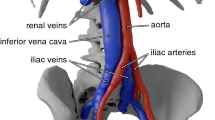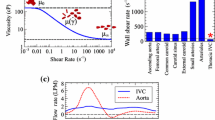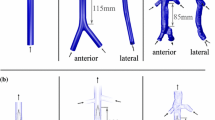Abstract
Purpose
Although many previous computational fluid dynamics (CFD) studies have investigated the hemodynamics in the inferior vena cava (IVC), few studies have compared computational predictions to experimental data, and only qualitative comparisons have been made. Herein, we provide particle image velocimetry (PIV) measurements of flow in a patient-averaged IVC geometry under idealized conditions typical of those used in the preclinical evaluation of IVC filters.
Methods
Measurements are acquired under rest and exercise flow rate conditions in an optically transparent model fabricated using 3D printing. To ensure that boundary conditions are well-defined and to make follow-on CFD validation studies more convenient, fully-developed flow is provided at the inlets (i.e., the iliac veins) by extending them with straight rigid tubing longer than the estimated entrance lengths. Velocity measurements are then obtained at the downstream end of the tubing to confirm Poiseuille inflow boundary conditions.
Results
Measurements in the infrarenal IVC reveal that flow profiles are blunter in the sagittal plane (minor axis) than in the coronal plane (major axis). Peak in-plane velocity magnitudes are 4.9 cm/s and 27 cm/s under the rest and exercise conditions, respectively. Flow profiles are less parabolic and exhibit more inflection points at the higher flow rate. Bimodal velocity peaks are also observed in the sagittal plane at the elevated flow condition.
Conclusions
The IVC geometry, boundary conditions, and infrarenal velocity measurements are provided for download on a free and publicly accessible repository at https://doi.org/10.6084/m9.figshare.7198703. These data will facilitate future CFD validation studies of idealized, in vitro IVC hemodynamics and of similar laminar flows in vascular geometries.






Similar content being viewed by others
References
ASME V&V 40 Committee. Draft V&V 40—Standard for Verification and Validation in Computational Methods for Medical Devices. New York: American Society of Mechanical Engineers, 2018.
Aycock, K. I., R. L. Campbell, F. C. Lynch, K. B. Manning, and B. A. Craven. The importance of hemorheology and patient anatomy on the hemodynamics in the inferior vena cava. Ann. Biomed. Eng. 44(12):3568–3582, 2016.
Aycock, K. I., R. L. Campbell, F. C. Lynch, K. B. Manning, and B. A. Craven. Computational predictions of the embolus-trapping performance of an IVC filter in patient-specific and idealized IVC geometries. Biomech. Model. Mechanobiol. 16(6):1957–1969, 2017.
Aycock, K. I., R. L. Campbell, K. B. Manning, and B. A. Craven. A resolved two-way coupled CFD/6-DOF approach for predicting embolus transport and the embolus-trapping efficiency of IVC filters. Biomech. Model. Mechanobiol. 16(3):851–869, 2017.
Aycock, K. I., R. L. Campbell, K. B. Manning, S. P. Sastry, S. M. Shontz, F. C. Lynch, and B. A. Craven. A computational method for predicting inferior vena cava filter performance on a patient-specific basis. J. Biomech. Eng. 136(8):081003, 2014.
Aycock, K. I., P. Hariharan, and B. A. Craven. Particle image velocimetry measurements in an anatomical vascular model fabricated using inkjet 3D printing. Exp. Fluids 58(11):154, 2017.
Berg, P., D. Stucht, G. Janiga, O. Beuing, O. Speck, and D. Thévenin. Cerebral blood flow in a healthy circle of Willis and two intracranial aneurysms: computational fluid dynamics versus four-dimensional phase-contrast magnetic resonance imaging. J. Biomech. Eng. 136(4):041003, 2014.
Bos, A., T. Van Ha, D. van Beek, M. Ginsburg, S. Zangan, R. Navuluri, J. Lorenz, and B. Funaki. Strut penetration: local complications, breakthrough pulmonary embolism, and retrieval failure in patients with Celect vena cava filters. J. Vasc. Interv. Radiol. 26(1):101–106, 2015.
Butscher, D., C. Hutter, S. Kuhn, and P. Rudolf von Rohr. Particle image velocimetry in a foam-like porous structure using refractive index matching: a method to characterize the hydrodynamic performance of porous structures. Exp. Fluids 53:1123–1132, 2012.
Cebral, J. R., M. A. Castro, J. E. Burgess, R. S. Pergolizzi, M. J. Sheridan, and C. M. Putman. Characterization of cerebral aneurysms for assessing risk of rupture by using patient-specific computational hemodynamics models. Am. J. Neuroradiol. 26(10):2550–2559, 2005.
Chen, Y., X. Deng, X. Shan, and Y. Xing. Study of helical flow inducers with different thread pitches and diameters in vena cava. PLoS ONE 13(1):e0190609, 2018.
Chen, Y., P. Zhang, X. Deng, Y. Fan, Y. Xing, and N. Xing. Improvement of hemodynamic performance using novel helical flow vena cava filter design. Sci. Rep. 7:40724, 2017.
Cheng, C. P., R. J. Herfkens, and C. A. Taylor. Inferior vena caval hemodynamics quantified in vivo at rest and during cycling exercise using magnetic resonance imaging. Am. J. Physiol. Heart Circ. Physiol. 284(4):H1161–H1167, 2003.
Ciozda, W., I. Kedan, R. Khandwalla, R. Zimmer, and A. Kimchi. The efficacy of sonographic measurement of inferior vena cava diameter as an estimate of central venous pressure. Cardiology 134:156, 2016.
Craven, A., K. I. Aycock, M. Z. Gallagher, and K. B. Manning. Steady flow in a patient-averaged inferior vena cava - Part II: Computational Fluid Dynamics Verification and Validation. Cardiovasc. Eng. Technol. In press, 2018.
Ha, H., M. Ziegler, M. Welander, N. Bjarnegård, C.-J. Carlhäll, M. Lindenberger, T. Länne, T. Ebbers, and P. Dyverfeldt. Age-related vascular changes affect turbulence in aortic blood flow. Front. Physiol. 9:36, 2018.
Hariharan, P., M. Giarra, V. Reddy, S. W. Day, K. B. Manning, S. Deutsch, S. F. Stewart, M. R. Myers, M. R. Berman, G. W. Burgreen, et al. Multilaboratory particle image velocimetry analysis of the FDA benchmark nozzle model to support validation of computational fluid dynamics simulations. J. Biomech. Eng. 133(4):041002, 2011.
Hostetter, T. H. Human renal response to meat meal. Am. J. Physiol. 250(4):F613–F618, 1986.
Hunter, J. D. Matplotlib: a 2D graphics environment. Comput. Sci. Eng. 9(3):90–95, 2007.
Jaeger, H. J., S. Kolb, T. Mair, M. Geller, A. Christmann, R. K. Kinne, K. D. Mathias, et al. In vitro model for the evaluation of inferior vena cava filters: effect of experimental parameters on thrombus-capturing efficacy of the VenaTech-LGM filter. J. Vasc. Interv. Radiol. 9(2):295–304, 1998.
Kalantarinia, K., J. T. Belcik, J. T. Patrie, and K. Wei. Real-time measurement of renal blood flow in healthy subjects using contrast-enhanced ultrasound. Am. J. Physiol. 297:F1129–F1134, 2009.
Korakianitis, T., and Y. Shi. Numerical simulation of cardiovascular dynamics with healthy and diseased heart valves. J. Biomech. 39(11):1964–1982, 2006.
Laborda, A., W. T. Kuo, I. Ioakeim, I. De Blas, M. Malvè, C. Lahuerta, and M. A. De Gregorio. Respiratory-induced haemodynamic changes: a contributing factor to IVC filter penetration. Cardiovasc. Intervent. Radiol. 38(5):1192–1197, 2015.
Laborda, A., S. Sierre, M. Malvè, I. De Blas, I. Ioakeim, W. T. Kuo, and M. A. De Gregorio. Influence of breathing movements and valsalva maneuver on vena caval dynamics. World J. Radiol. 6(10):833, 2014.
Malinauskas, R. A., P. Hariharan, S. W. Day, L. H. Herbertson, M. Buesen, U. Steinseifer, K. I. Aycock, B. C. Good, S. Deutsch, K. B. Manning, et al. FDA benchmark medical device flow models for CFD validation. ASAIO J. 63(2):150–160, 2017.
Mandelbaum, A., and E. Ritz. Vena cava diameter measurement for estimation of dry weight in haemodialysis patients. Nephrol. Dial. Transplant. 11(2):24–27, 1996.
Marsden, A. L., A. J. Bernstein, V. M. Reddy, S. C. Shadden, R. L. Spilker, F. P. Chan, C. A. Taylor, and J. A. Feinstein. Evaluation of a novel y-shaped extracardiac Fontan baffle using computational fluid dynamics. J. Thorac. Cardiovasc. Surg. 137(2):394–403, 2009.
Migliavacca, F., P. J. Kilner, G. Pennati, G. Dubini, R. Pietrabissa, R. Fumero, and M. R. de Leval. Computational fluid dynamic and magnetic resonance analyses of flow distribution between the lungs after total cavopulmonary connection. IEEE Trans. Biomed. Eng. 46(4):393–399, 1999.
Mismetti, P., S. Laporte, O. Pellerin, P.-V. Ennezat, F. Couturaud, A. Elias, N. Falvo, N. Meneveau, I. Quere, P.-M. Roy, et al. Effect of a retrievable inferior vena cava filter plus anticoagulation vs anticoagulation alone on risk of recurrent pulmonary embolism: a randomized clinical trial. JAMA 313(16):1627–1635, 2015.
Moreno, F. L., A. D. Hagan, J. R. Holmen, T. A. Pryor, R. D. Strickland, and C. H. Castle. Evaluation of size and dynamics of the inferior vena cava as an index of right-sided cardiac function. Am. J. Cardiol. 53(4):579–585, 1984.
Murphy, E. H., E. D. Johnson, and F. R. Arko. Evaluation of wall motion and dynamic geometry of the inferior vena cava using intravascular ultrasound: implications for future device design. J. Endovasc. Ther. 15(3):349–355, 2008.
Najjari, M. R., J. A. Hinke, K. V. Bulusu, and M. W. Plesniak. On the rheology of refractive-index-matched, non-Newtonian blood-analog fluids for PIV experiments. Exp. Fluids 57(6):96, 2016.
Nicolas, M., M. Malve, E. Peña, M. Martínez, and R. Leask. In vitro comparison of Günther Tulip and Celect filters: Testing filtering efficiency and pressure drop. J. Biomech. 48(3):504–511, 2015.
Nicolás, M., V. Palero, E. Pena, M. Arroyo, M. Martínez, and M. Malvè. Numerical and experimental study of the fluid flow through a medical device. Int. Commun. Heat Mass Transfer 61:170–178, 2015.
Oliphant, T. E. Python for scientific computing. Comput. Sci. Eng. 9(3):10–20, 2007.
Pekkan, K., B. Whited, K. Kanter, S. Sharma, D. De Zelicourt, K. Sundareswaran, D. Frakes, J. Rossignac, and A. P. Yoganathan. Patient-specific surgical planning and hemodynamic computational fluid dynamics optimization through free-form haptic anatomy editing tool (SURGEM). Med. Biol. Eng. Compu. 46(11):1139–1152, 2008.
PREPIC Study Group. Eight-year follow-up of patients with permanent vena cava filters in the prevention of pulmonary embolism: the PREPIC (Prevention du Risque d’Embolie Pulmonaire par Interruption Cave) randomized study. Circulation 112(3):416–422, 2005.
Qian, Y., J. Liu, K. Itatani, K. Miyaji, and M. Umezu. Computational hemodynamic analysis in congenital heart disease: simulation of the Norwood procedure. Ann. Biomed. Eng. 38(7):2302–2313, 2010.
Rahbar, E., D. Mori, and J. E. Moore, Jr. Three-dimensional analysis of flow disturbances caused by clots in inferior vena cava filters. J. Vasc. Interv. Radiol. 22(6):835–842, 2011.
Ren, Z., S. L. Wang, and M. A. Singer. Modeling hemodynamics in an unoccluded and partially occluded inferior vena cava under rest and exercise conditions. Med. Biol. Eng. Comput. 50(3):277–287, 2012.
Roach, M. R., S. Scott, and G. G. Ferguson. The hemodynamic importance of the geometry of bifurcations in the circle of Willis (glass model studies). Stroke 3(3):255–267, 1972.
Robinson, R. A., L. H. Herbertson, S. S. Das, R. A. Malinauskas, W. F. Pritchard, and L. W. Grossman. Limitations of using synthetic blood clots for measuring in vitro clot capture efficiency of inferior vena cava filters. Med. Devices (Auckl.) 6:49, 2013.
Roy, C. J., and W. L. Oberkampf. A comprehensive framework for verification, validation, and uncertainty quantification in scientific computing. Comput. Methods Appl. Mech. Eng. 200:2131–2144, 2011.
Singer, M. A., W. D. Henshaw, and S. L. Wang. Computational modeling of blood flow in the Trapease inferior vena cava filter. J. Vasc. Interv. Radiol. 20(6):799–805, 2009.
Singer, M. A., and S. L. Wang. Modeling blood flow in a tilted inferior vena cava filter: does tilt adversely affect hemodynamics? J. Vasc. Interv. Radiol. 22(2):229–235, 2011.
Singer, M. A., S. L. Wang, and D. P. Diachin. Design optimization of vena cava filters: an application to dual filtration devices. J. Biomech. Eng. 132(10):101006, 2010.
Song, M. S., H. Y. Choi, J. H. Seong, and E. S. Kim. Matching-index-of-refraction of transparent 3D printing models for flow visualization. Nucl. Eng. Des. 284:185–191, 2015.
Stehbens, W. Turbulence of blood flow. Q. J. Exp. Physiol. Cognate Med. Sci. Transl. Integr. 44(1):110–117, 1959.
Steinman, D. A. Image-based computational fluid dynamics modeling in realistic arterial geometries. Ann. Biomed. Eng. 30(4):483–497, 2002.
Stewart, S. F., E. G. Paterson, G. W. Burgreen, P. Hariharan, M. Giarra, V. Reddy, S. W. Day, K. B. Manning, S. Deutsch, M. R. Berman, et al. Assessment of CFD performance in simulations of an idealized medical device: results of FDAs first computational interlaboratory study. Cardiovasc. Eng. Technol. 3(2):139–160, 2012.
Stewart, S. F., R. A. Robinson, R. A. Nelson, and R. A. Malinauskas. Effects of thrombosed vena cava filters on blood flow: flow visualization and numerical modeling. Ann. Biomed. Eng. 36(11):1764, 2008.
Sundareswaran, K. S., D. de Zélicourt, S. Sharma, K. R. Kanter, T. L. Spray, J. Rossignac, F. Sotiropoulos, M. A. Fogel, and A. P. Yoganathan. Correction of pulmonary arteriovenous malformation using image-based surgical planning. JACC Cardiovasc. Imaging 2(8):1024–1030, 2009.
Swaminathan, T., H. H. Hu, and A. A. Patel. Numerical analysis of the hemodynamics and embolus capture of a greenfield vena cava filter. J. Biomech. Eng. 128(3):360–370, 2006.
Taylor, J. O., B. C. Good, A. V. Paterno, P. Hariharan, S. Deutsch, R. A. Malinauskas, and K. B. Manning. Analysis of transitional and turbulent flow through the FDA benchmark nozzle model using laser Doppler velocimetry. Cardiovasc. Eng. Technol. 7(3):191–209, 2016.
Tedaldi, E., C. Montanari, K. I. Aycock, F. Sturla, A. Redaelli, and K. B. Manning. An experimental and computational study of the inferior vena cava hemodynamics under respiratory-induced collapse of the infrarenal IVC. Med. Eng. Phys. 54:44–55, 2018.
Tsui, B., T. An, E. Moon, R. King, and W. Wang. Retrospective review of 516 implantations of option inferior vena cava filters at a single health care system. J. Vasc. Interv. Radiol. 27(3):345–353, 2016.
US Food and Drug Administration. Reporting of Computational Modeling Studies in Medical Device Submissions. Rockville, MD: US Food and Drug Administration, 2016.
Van der Walt, S., S. C. Colbert, and G. Varoquaux. The NumPy array: a structure for efficient numerical computation. Comput. Sci. Eng. 13(2):22–30, 2011.
Wang, S. L., A. Siddiqui, and E. Rosenthal. Long-term complications of inferior vena cava filters. J. Vasc. Surg. Venous Lymphat. Disord. 5(1):33–41, 2017.
Wang, S. L., and M. A. Singer. Toward an optimal position for inferior vena cava filters: computational modeling of the impact of renal vein inflow with Celect and TrapEase filters. J. Vasc. Interv. Radiol. 21(3):367–374, 2010.
Yazdi, S. G., P. H. Geoghegan, P. D. Docherty, M. Jermy, and A. Khanafer. A review of arterial phantom fabrication methods for flow measurement using PIV techniques. Ann. Biomed. Eng. 2018. https://doi.org/10.1007/s10439-018-2085-8.
Acknowledgments
We thank Prasanna Hariharan for reviewing the manuscript and for helpful discussions. This study was supported by the FDA Critical Path Initiative (HHSF223201610405P) and the Penn State College of Engineering Instrumentation Grant. The findings and conclusions in this article have not been formally disseminated by the U.S. FDA and should not be construed to represent any agency determination or policy. The mention of commercial products, their sources, or their use in connection with material reported herein is not to be construed as either an actual or implied endorsement of such products by the Department of Health and Human Services.
Conflict of Interest
The authors declare that they have no conflicts of interest.
Author information
Authors and Affiliations
Corresponding author
Additional information
Associate Editors Dr. David A. Steinman, Dr. Francesco Migliavacca, and Dr. Ajit P. Yoganathan oversaw the review of this article.
M. B. Gallagher and K. I. Aycock contributed equally to this work.
Rights and permissions
About this article
Cite this article
Gallagher, M.B., Aycock, K.I., Craven, B.A. et al. Steady Flow in a Patient-Averaged Inferior Vena Cava—Part I: Particle Image Velocimetry Measurements at Rest and Exercise Conditions. Cardiovasc Eng Tech 9, 641–653 (2018). https://doi.org/10.1007/s13239-018-00390-2
Received:
Accepted:
Published:
Issue Date:
DOI: https://doi.org/10.1007/s13239-018-00390-2




